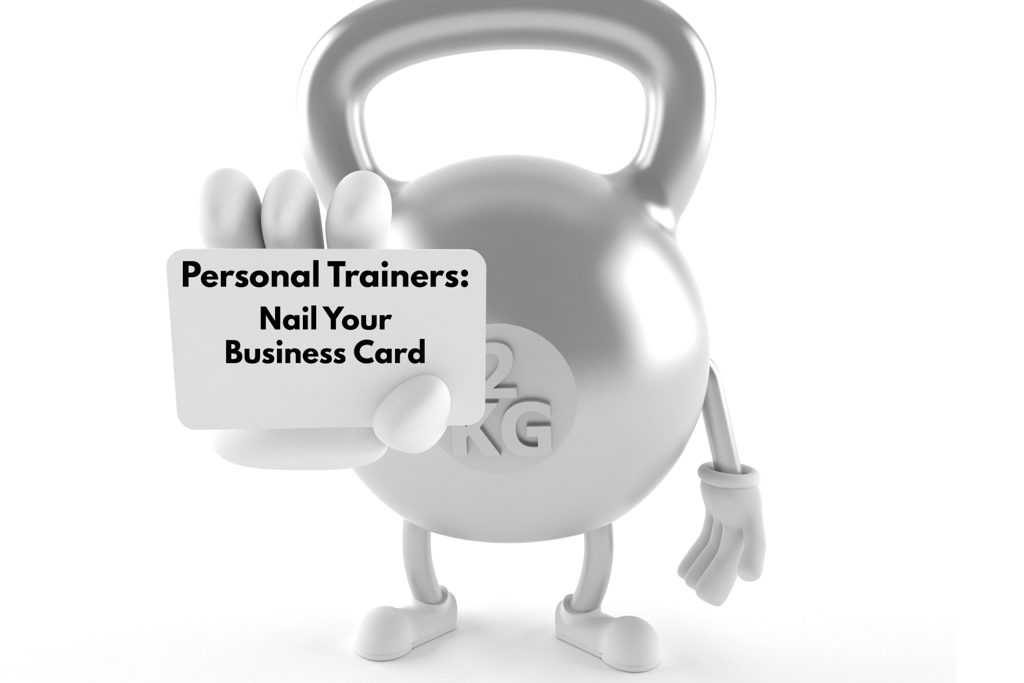The best personal trainer business cards do exactly one thing: Help the people holding them contact you.
Below, we’ll go over the finer points of personal trainer business cards. And we’ll offer some tips to help you create a great card.
Here’s our over-arching piece of advice:
When it comes to personal trainer business cards, clarity is more important than art.
Yes, business card design trends are always changing. In 2021, design experts are promoting QR codes, digital business cards, translucent card stock, interactive cards and cards with cutouts, photos, clever patterns and color schemes, special fonts, and more.
The one thing that never changes: A personal trainer business card exists to help your clients contact you easily.
Remember: You aren’t in a fitness business card contest. And your coaching business card doesn’t make the sale. You do.
Personal Trainer Business Cards: The Essentials
The experts at business card giant Vistaprint list seven elements as essential on a business card for a personal trainer or coach:
- Name.
- Company name (if you have one).
- Logo.
- Title.
- Contact info (perhaps including social media).
- Website address.
- Tagline/call to action.
Most of it is very simple, but we’ll dive into a few items on the list to give coaches and trainers info specific to the fitness industry.
Contact Info: What to Include
How much contact info should go on a personal trainer business card? You need to know your market. It’s standard to include your phone number, address, website and email address. And some even include social media accounts as more and more consumers use Facebook and Instagram to contact businesses and service providers.
But real estate is at a premium on a standard business card, which measures 3.5 by 2 inches (8.9 x 5.1 cm). So you could drop a few elements if you know your market so well that doing so carries no risk.
For example, if you specialize in training clients over 70 in their homes and know that they prefer the phone and will never use a computer, you might drop social handles, email address and physical business address from the card.
Similarly, if you run an online training business and your desired clients are all on the web, you might consider omitting a phone number—especially if it always leads callers to a full voice mailbox. This omission will actually help you screen out clients you don’t want. But you will miss out on tech-savvy people who still want to call you.
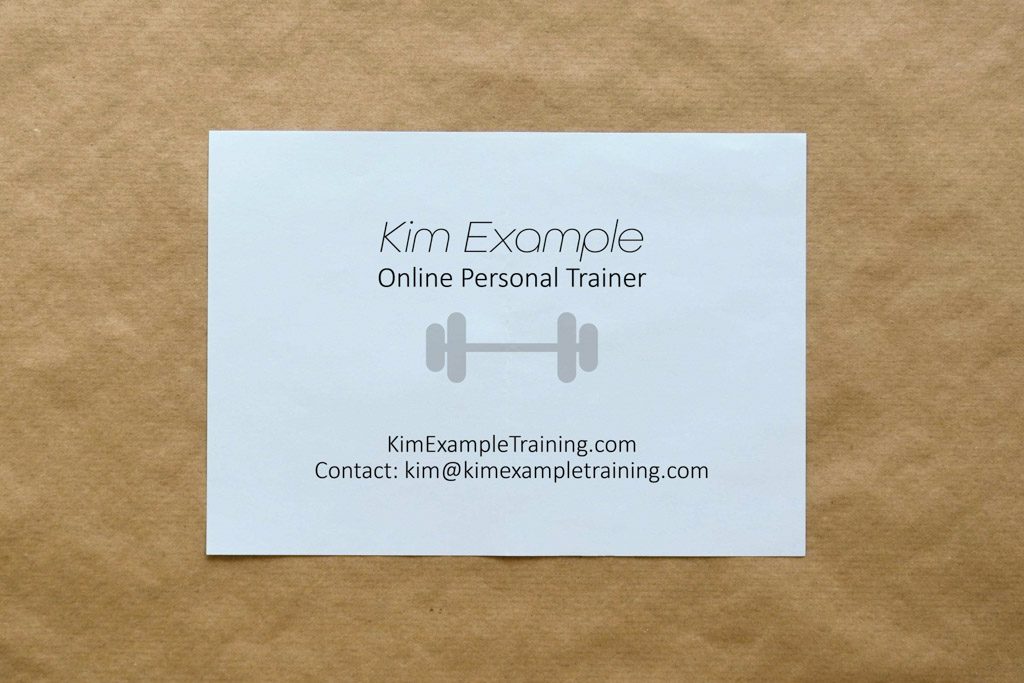
You can decide if omission of any element is bold or brash as you identify the characteristics and preferences of your perfect clients.
Overall, decisions to omit “essential” contact elements should be made with great care. If you aren’t sure, include them all. But don’t clutter your card.
What to Omit: Key Advice for Personal Trainers
Is it important to list credentials on a personal trainer business card? Not really. Few clients will know what the alphabet soup means.
Sam Smith – B.Sc., NSCA CSCS, ACSM CPT, NASM-CPT
That’s ugly.
Spell out the initialisms and you’re giving away even more turf to the National Strength and Conditioning Association, American College of Sports Medicine and National Academy of Sports Medicine.
Credentials are often most important to the people who hold them. The fitness world offers a host of certifications and designations, and most clients don’t have any way to differentiate them. It’s much more important that people know what you do, not exactly what qualifies you to do it. You should tell prospective clients you’re qualified and insured, and you should provide any info they need to feel confident in you. But you don’t need to use your card to do it.
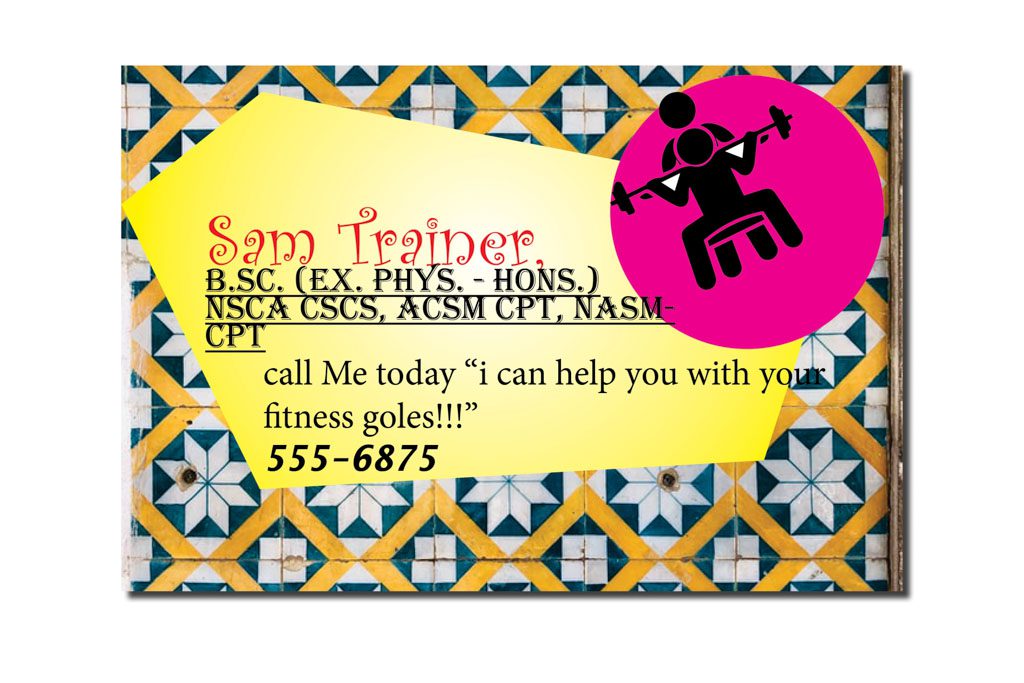
Remember: Your business card is designed to help people contact you. If you know your market and honestly believe more people will contact you because they see “ISSA-CPT” or something similar, include the designation. If it’s likely people won’t know what the letters mean or won’t care, leave them off and include them in the “about” section of your website.
Need to do some research? Print out two sample cards and ask friends which one would give them more important info:
“Sam Smith, Certified Personal Trainer” or “Sam Smith, ACE-CPT”?
Taglines and Calls to Action
The Gym Lead Machine crew said someone must be able to figure out what you do within 10 seconds of landing on your website. That great advice applies to any promotional materials—including a card for a training business.
Simply put, you need to think of your personal trainer business card as your “physical website.” Anyone who sees it must know what you do immediately.
And the card must make the next step obvious to the holder. On a website, you need a call to action. On a business card, the call to action is implied: Contact me. With that in mind, you must make your contact info very clear. Your business card is not a puzzle in “The Da Vinci Code.” No one wants a mystery. Everyone wants clarity.
Businesses regularly drop the ball with taglines that are clear only to the people in the business. Example: “World-Class Digital Solutions.”
For what? Who cares? <potential client closes browser window>
Common tagline temptations: being too clever, using industry jargon, being vague.
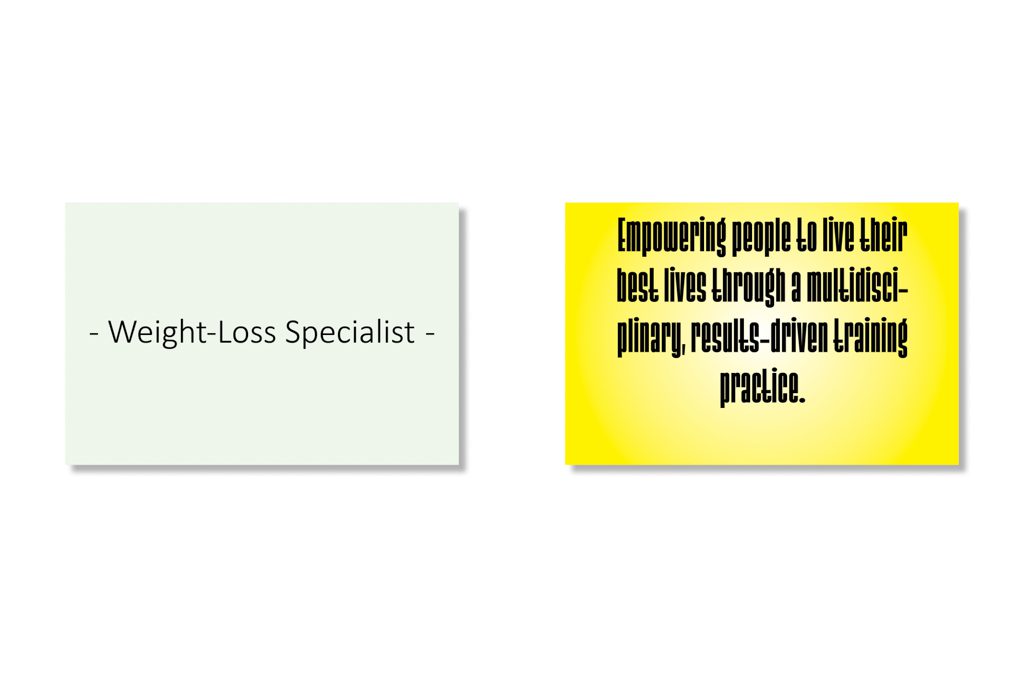
Great taglines are blunt and direct:
- Weight-loss specialist.
- Strength training for college athletes.
- Injury prevention for seniors.
- Look better naked in 1 month.
Calls to action are similarly direct:
- Book a free consultation.
- Call to reserve your spot today.
- Visit website for free fitness guide.
For personal trainers, our advice is to use a very clear, very simple tagline that tells people what you do and how you solve problems for clients.
If you prefer a call to action, direct people to do the thing that brings you your best clients—”book a consultation,” “follow us on Instagram” and so on. If you choose this route, make sure your branding and title make it very clear what your business does.
You can place taglines and calls to action anywhere. We’d recommend you put them on the back side of the card with a large logo, but exact placement is up to you.
Design
Double-Sided? What Size?
Should your personal trainer business card be single sided or double sided?
Get a double-sided business card for your fitness business unless you plan to write something on the back, like an appointment time. But if that’s the case, we still recommend printing some lines or “Appointment time:” on the back so you aren’t just randomly scribbling “June 12, 2 p.m.”
You’re already paying for the card itself, so you might as well fill both sides, and a little extra ink won’t empty your wallet. According to Gimmio, 95 percent of business cards are double sided, and most sites with pre-made designs offer double-sided cards with only a modest price increase.
With two sides, you can spread elements out and avoid cramming everything on one side and making people squint.
Next, get a standard sized business card unless you have a really good reason to get a square card or odd-shaped card that won’t fit in a wallet, purse or portfolio. There’s a reason no one has a square credit card, so you need to balance your desire to stand out with the risk of presenting someone with a card that’s just plain annoying to handle.
As stated earlier, standard cards are 3.5 by 2 inches (8.9 x 5.1 cm).
Personal Trainer Business Cards: Other Design Elements
When it comes to colors, fonts and other elements, stick to your existing branding—if you have branding. If you don’t, it’s high time to address this element of your business before you print 5,000 cards. The finer points of branding are outside the scope of this article, so we’ll just supply three key pieces of advice:
1. Your logo, color scheme and font selections should be consistent across all your media. The overall package should be clear, attractive and professional. Choose wisely, then stick to the plan.
2. Your branding should be clear and concise, not obtuse and esoteric.
3. If you can’t figure out what to do quickly, hire a pro and get back to training clients. Don’t waste time trying to figure out print bleeds in Adobe InDesign.
With that in mind, your card should reflect the overall look of your business—your sign (if you have a physical location), your training sheets, your branded app (click here for our review of the best ones), and so on. Consistency says “professional.”
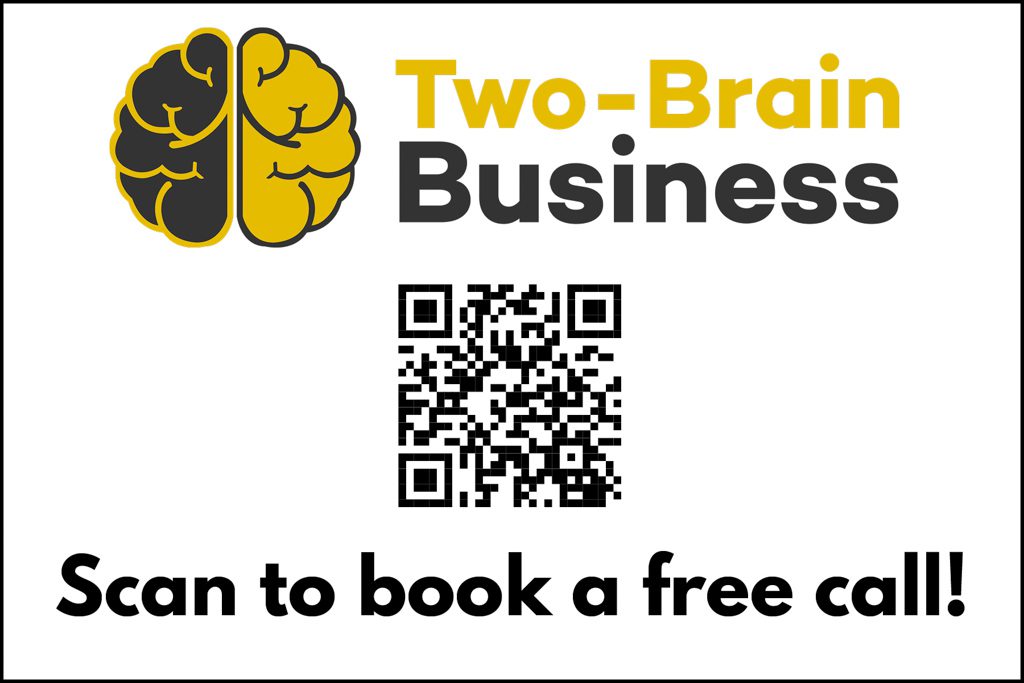
2021 Design Trends—and What They Mean for Coaches
99designs.com published this article and listed eight top business-card trends for 2021.
Among the trends: almost-identical business cards that use different color schemes, geometric designs, clever cutouts and so on. We would advise personal trainers to ignore these trends. You are not creating art. You are selling a service. Stay focused.
With that in mind, two current trends from the list are worthy of consideration:
1. Big text—simplicity is key. Imagine one side of your card simply says “Get Stronger in 2 Weeks,” “Weight-Loss Expert” or “Free Nutrition Consultations” in large letters that take up most of the real estate. You’d hand that card to a person and he or she would know what you do without a doubt. That’s a win.
2. QR codes—A QR code can be scanned with a mobile device to obtain information. Not all consumers understand what the “square bar code” does, but those who do find them very handy. Imagine the back of your card said “Book a Free Consultation” and had a QR code that took the scanner directly to your booking page. Take a picture of the code above with your phone and see what happens.
Or you could link to a website page with testimonials and social proof. Maybe you want to use a QR code to make it easy for people to add your contact info to their mobile devices. Or perhaps you want to send people to your social platforms. These codes bridge the gap between the physical and the digital, and, when used wisely, they can help tech-savvy clients connect with you fast.
We strongly recommend you meet with prospective clients through a free consultation, and a QR code that directs them to your booking page could pay for your entire print run if it leads to a single sale.
The down side: The codes aren’t particularly pretty. But that doesn’t matter if they do some heavy lifting for you and your training business.
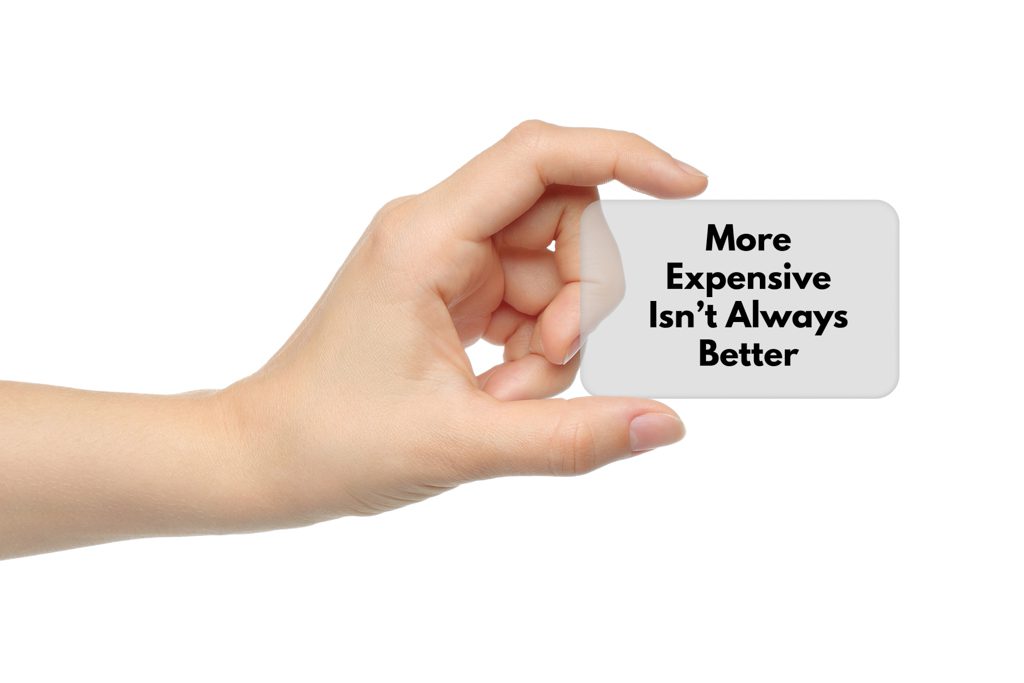
Cost of Cards for Personal Trainers
The cost of business cards for personal trainers varies from a few cents to well over a dollar per card. You have infinite options.
Two general rules:
- The fancier you make them, the more expensive they are.
- The more you print, the lower the price per unit.
Printers offer a host of options, including foil accents and finishes, and many will design cards for you for a fee.
Just to give you an idea of the price range, here are six options from Vistaprint:
- 500 standard cards (premium thickness, matte paper stock, standard corners): $26.99, or 5.3 cents per card. Add a full-color second side for an extra $15 or so (depending on design), bringing the price to about 8.4 cents per card. Add a foil accent to the double-sided card and the price goes to about 12 cents each.
- 500 standard cards (premium plus thickness, glossy paper stock, rounded corners): $50, or 10 cents per card. Add a full-color second side for an extra $15 or so (depending on design), bringing the price to about 13 cents per card.
- 100 premium cards (no finish, standard corners): $15, or 15 cents per card. A second side runs about $8 per 100, or 23 cents per card.
- 100 premium cards (embossed gloss finish, rounded corners): $37.50, or 37.5 cents per card. A second side runs about $8 per 100, or 45.5 cents per card.
- 50 double-sided flexible plastic cards: $67, or $1.34 each. A second side will cost about $6 for 50, bringing the price to about $1.46 per card.
- 50 double-sided rigid plastic cards: $79.50, or $1.59 each. A second side will cost about $6 for 50, bringing the price to about $1.71 per card.
How Much Should a Personal Trainer Spend on a Business Card?
Your personal trainer business card is a tool, not a work of art. It needs to be functional and professional, not clever or beautiful. We recommend you go with economical options, which still look great in most cases.
Considering most of the world is digital now, there’s little point in spending a ton of money on cards likely to be thrown out immediately or eventually.
And you can get 500 very nice cards with some premium options for about $65—so you don’t have to spend a lot to get something that looks pro.
In actuality, the greater concern is really the time you spend on your cards. If you charge clients $70 per hour and spend three hours designing “the perfect card,” the price is actually $260 if you order 500 at $50—with $210 representing the cost of your time.
Don’t overthink it.
Do You Need Ultra-Cool Plastic Business Cards?
We recommend you stay away from expensive plastic cards.
Paying $1.60 for a single card is a little extreme—and are you going to acquire more clients with the flashy cards? It’s doubtful. If you can definitively say costly cards will convert more clients, get them. But you probably can’t and really just want a super-cool card.
Despite our recommendation to go with relatively inexpensive cards, you might choose to spend extra for two reasons:
1. You are targeting very high end clients and offering super-expensive services. In this case, a fancy card might be part of your branding—but you just can’t guarantee it won’t end up in the trash can. We still wouldn’t advise you to break the bank in this scenario.
2. You are heading to a trade show or other forum where prospective clients are collecting stacks of cards from personal trainers. In this case, you might want to stand out from the crowd. Maybe you go with a slightly larger card that literally sticks out of the pile. Or you use a premium finish. If you go this route, we strongly recommend you use your “premium cards” at these events only and get a cheaper stack you can use every day. And we wouldn’t hand premium cards out to anyone and everyone. We’d reserve them for the people who seem most genuinely interested, not tire kickers who like “free stuff.”

Business Card Etiquette for Personal Trainers
You’re a professional, so act like one when it comes to business cards.
1. Have business cards handy and make sure they aren’t bent, torn or dirty. When someone asks for a card, you should be able to produce a mint condition card in seconds. If you need to say “hold on” while you dig through pockets for a tattered card, it isn’t going to be well received.
2. Present the card with the text facing the receiver, and don’t cover any of it up. You want the person to see the details immediately.
3. Smile and look the person in the eyes. That’s good advice for any interaction.
4. Ask for a card in return if the person is likely to have one. When you are given a card, receive it in the manner in which it was presented. For example, if it’s presented with two hands, receive it with two hands. Thank the person and show your interest by making a comment about the card or the business: “I grew up in that area” or “that’s a beautiful logo.” Carefully put the card in a “place of honor”—the person who gave it to you is likely proud of it. So don’t fold it and stuff it in your jacket.
Business Cards and Personal Trainers: Our Top Advice
The closing advice here applies no matter what your card looks like. It supersedes every single design choice, and it will earn you more fitness and nutrition clients than the most beautiful business card.
1. If you exchange cards with a prospective client, don’t wait for the call. Reach out first and keep the conversation going.
“I enjoyed meeting you earlier today and talking golf! Here’s an article I wrote on core strength for golfers. Let me know what you think of it.”
2. If you don’t get a card from a prospective client, try to obtain contact info to continue the dialogue.
“Here’s my card. Do you have an email address? I’d love to add you to my mailing list and send you my top 10 nutrition tips.”
3. No matter what your card looks like, don’t rely on it to do the work for you.
If you are having a face-to-face conversation, you, as a charming fitness professional, are in your element. Your character is far more powerful than your logo and font choices.
Be your kind, engaging, helpful self. Convince the person to contact you with your words, actions, professionalism and level of care. Then supply the card that makes contact easy. Don’t casually hand out cards and expect them to work wonders.
Potential clients aren’t looking for the coolest personal trainer business cards. They’re looking for the personal trainer who will help them accomplish their goals fastest.
